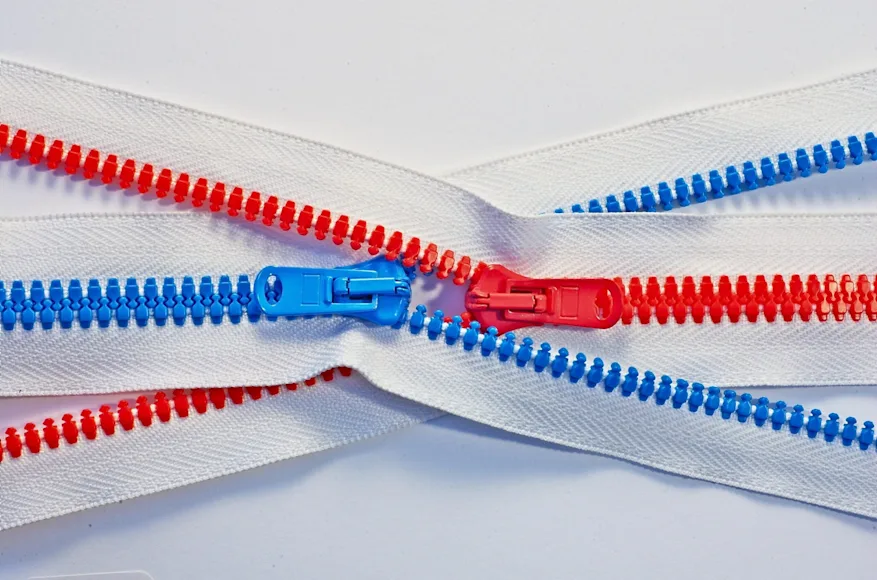_We may earn revenue from the products available on this page and participate in affiliate programs. Learn more ›
_
Zippers are a part of many pieces of gear. From our jackets to our tents and backpacks, having a functional zipper can keep us warm, dry, and all of our gear contained.
What happens when that zipper fails, though?
Our gear’s first line of defense is to carry out proper and consistent maintenance. Maintenance of equipment includes inspections, cleaning, and of course, sometimes repairs.
Repairing or replacing zippers is often more manageable when you are in the comfort of your home and have access to various tools. It can be done in the field if necessary, and even with all of the proper precautions, gear breaks still happen, so it helps to be prepared.
_Always be prepared for gear repairs with a well-stocked repair kit.
_
Zipper Maintenance
Keeping all of your zippers clean and well lubricated can help prevent zipper degradation and improve your equipment’s lifespan. Dirt, grime, rust, salt, sand, corrosion, and more can all lead to the zipper getting stuck due to the additional friction.
Pro Tip: Anytime you are in or around saltwater, always wash your gear and zippers immediately after use to prevent corrosion.
All of that extra friction can lead to the zipper teeth breaking or the slider being pushed off or bending. To prevent these things from happening, keep the zipper clean and well lubricated. Invest in a specialized cleaner and lubricant to make this process easier. Gear Aid makes a Zipper Cleaner and Lubricant that is easy to use and works wonders in removing all types of grime and debris from various zippers.
To use the Gear Aid Zipper Cleaner and Lubricant
, follow these simple steps:
Unzip the zipper fully.
Use a brush to remove debris, dirt, and grime from the zipper.
Brush the cleaner onto the zipper to lubricate the zipper teeth.
Wipe off excess lubricant.
Zip and unzip the zipper slowly a few times to better distribute the lubricant.
Doing this as a part of your annual gear care or when you notice a zipper has started to get stuck from time to time will save you from having to repair most of your zippers down the line.
How to Repair a Zipper
Whether or not you keep up with cleaning and lubricating your zippers, having to repair a zipper is better than a full replacement. Knowing the basics of zipper repair and having a few zipper repair items
on hand while in the backcountry is helpful.
First, if the zipper is stuck and not caught on any fabric, there is likely some gunk or debris jamming the zipper. Although it is tempting, avoid using a lubricant you may have on hand (like vaseline or chapstick). The first line of defense is to try and clean the zipper out. Lubricants like vaseline can attract more dirt to the area, further clogging the zipper.
Use liquid or some soap to clean the area. If you have a toothbrush on hand, this can also assist in the cleaning. Otherwise, use a wet cloth. Avoid pulling the zipper apart as this can damage the teeth, making repairs more difficult.
Getting a zipper unstuck is relatively easy and can be done with minimal tools. It may be one of the most common zipper fixes needed, but another fix you may run into is having to replace or repair a zipper slider.
If possible, try to use the original slider. Sometimes, the slider gets too loose and can be tightened slightly with pliers. Take caution not to over-tighten the slider or the zipper won’t work anymore.
To replace a slider, follow these steps:
Unzip the zipper and move the slider to the bottom of the zipper teeth.
Use end nip pliers to pinch the zipper’s topper and pull it from the fabric. If the topper is metal, you can use needle nose pliers to do this. A seam ripper can also be used for fabric stoppers.
Remove the old slider.
Remember the direction it goes onto the zipper so you can put the new one on correctly.
Put a new slider onto the zipper teeth with the “nose” facing up.
Use long nose pliers to squeeze the stopper onto the zipper.
Crimp a new zipper stop onto the end of the zipper.
Using a zipper repair kit
is ideal in this situation as it will provide you with all of the necessary materials other than the pliers. Before going through this process, make sure the new slider is the correct size and type for the zipper you’re repairing.
The instructions above are for zippers that unzip entirely, like those on jackets. The process is essentially the same for close-looped zippers found on many tents and backpacks. The main difference is that you need to unstitch and restitch the zipper end/stopper.
How to Replace a Zipper
Replacing the entire zipper is a much bigger project, which is why we recommend keeping up with proper zipper care and maintenance to prevent this from ever happening. Since replacing a zipper requires some basic sewing knowledge and skills, consider bringing your jacket or gear with a broken zipper into a repair shop.
Many local gear consignment shops have repair programs, and most shoe repair shops can repair zippers at a relatively low cost. Another option is to see if the manufacturer has any repair programs.
If you feel like doing it yourself, utilize online video tutorials and follow these steps:
Measure the length of the broken zipper and purchase a zipper of the same length.
Remove the broken zipper using a seam ripper.
Pull the zipper off and remove any remaining threads.
Sew the new zipper onto one side. There should be a “pocket” seam that the zipper fits into to make this more straightforward to follow. The edge of the zipper tape needs to be aligned with the edge of the fabric.
Before you sew, align and pin the materials together to keep them in place.
A basting stitch is recommended.
Do the same on the other side.
To ensure the zippers are lined up, zip the zipper up before you sew. Then, pin the zipper in place and sew a few stitches. Unzip the zipper and continue.
This entire process can be done with hand stitching, but if you have a sewing machine and a zipper foot, the process is much faster and easier.
Remember that there will likely be some variation in how your zipper needs to be replaced. The steps described above are generalized to illustrate the process, but there may be some differences in the process you need to follow for the best results.
FAQ
Q: How do you get a zipper back on track?
To get a zipper back on track, push the teeth of the separated zipper together. The teeth should alternate left and right. Place the zipper on a hard surface and work your way up, pressing the teeth together and popping them back into place. The zipper teeth may be broken or damaged if this does not work.
Q: Can a zipper be fixed without replacing it?
Yes, a zipper can be fixed in some scenarios without a complete replacement. If the teeth are damaged, the zipper will need to be replaced, though.
Q: How much does it cost to get a zipper repaired on a jacket?
Depending on your location and the complexity of the zipper repair, it can cost anywhere from $10-100 to get a zipper repaired. We recommend getting a price quote before sending any gear in for a repair. Local repair shops tend to be more affordable than sending a product back to the manufacturer for repairs due to shipping costs.






